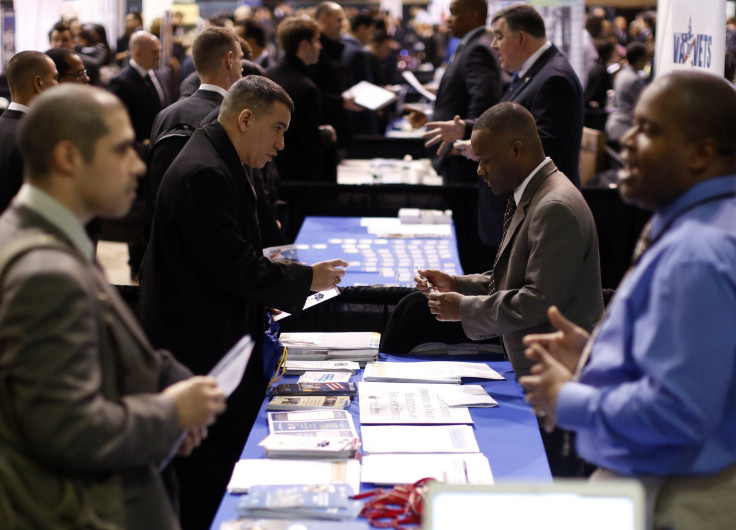US June Jobs Report 2013: Nonfarm Payrolls To Show Moderate Growth, Unemployment Rate To Drop To 7.5%

The prospect of the Federal Reserve beginning to scale back its quantitative easing program “within the next few meetings” has led to a renewed focus on economic data. As Fed Chairmen Ben Bernanke said at the Federal Open Market Committee announcement on June 19, any change in asset purchases “would reflect the incoming data and their implications for the outlook.”
A “status quo” June jobs report reflecting continued healing in the labor market will probably nudge the Fed closer to discussing tapering the pace of QE, in the belief that the U.S. economy and job market will bounce back by the end of the year.
The Labor Department will release the June employment report on Friday at 8:30 a.m. EDT.
The consensus forecast is that employers added 165,000 jobs in June, including 175,000 gains in the private sector and 10,000 cuts by federal, state and local governments. Manufacturing payrolls have fallen by an average of 7,000 in each of the three months to May, but economists are looking for little change in this category in the June report.
The six-month moving average of headline job growth in May was 194,000, remaining near 200,000 for a fourth straight month. While June’s headline figure is slightly lower than May’s 175,000, economists believe that last month’s pace of hiring will not put too large a dent in the Fed’s plans to slow down its bond-buying program later this year.
"Historically, June nonfarm payrolls have tended to be weak, possibly reflecting the difficulty in seasonally adjusting the data for the entry of students and the exiting of teachers ahead of the summer recess,” Deutsche Bank's Joe LaVorgna said in a note to clients.
“In point of fact, the strongest reading we have seen in the initially reported change on June nonfarm payrolls going back to 2000 has been just 146,000 (June 2005)," LaVorgna said, adding that he expects a gain of 145,000 jobs in June.
As Paul Dales, an economist at Capital Economics, pointed out: “The wild card, as is always the case in June, is whether more or fewer school leavers than normal entered the ranks of the employed rather than the unemployed.”
The unemployment rate probably retreated to 7.5 percent last month, matching April’s four-year low, from 7.6 percent in May, according to the median forecast of 89 economists in a Thomson Reuters survey ahead of the July 5 government report.
Friday’s jobs report is also expected to show that average hourly earnings rose by 0.2 percent after being flat in May. Meanwhile, the length of the average workweek is expected to have held steady at 34.5 hours.
Leading up to the June employment report, market participants will receive a few other labor-related reports, including the June ADP estimate of private payrolls and weekly jobless claims.
Private payroll processing firm ADP will likely announce on Wednesday that businesses added 160,000 jobs in June, higher than the 135,000 job created in May.
However, the ADP employment report has not been a useful real-time predictor of the change in private payrolls reported by the Bureau of Labor Statistics. The ADP report started using a new methodology in October and its track record is still largely unproven. The absolute value of the gap between the ADP and BLS data has averaged 42,000 since the change in methodology. For comparison, from January 2008 through September 2012 the average absolute miss was 81,000, according to Maury N. Harris, an economist with UBS Investment Research.
Also on Wednesday, investors will get the weekly initial jobless claims report. After falling in April and edging up in May, initial jobless claims have moved mostly sideways in June. The net result is a modest downtrend relative to its earlier pace. Claims have averaged 346,000 so far in the second quarter versus 356,000 in the first quarter and 377,000 in the fourth quarter of last year.
“Summer shutdowns of auto plants have the potential to add volatility to the claims data at the end of June and the beginning of July,” Harris said. “The shutdowns appear more limited than in past years, with some manufacturers not expecting as much downtime.”
U.S. auto sales are out Tuesday. Sales have been strong in recent months due to exceptionally low interest rates and rising consumer sentiment, which approached a six-year high at the end of June, according to figures released Friday. Economists surveyed by Reuters predict vehicle sales ramped up to 15.40 million in June from 15.24 in May.
Manufacturing activity, for its part, grew in June, rebounding from an unexpected contraction the prior month. The Institute for Supply Management said its index of national factory activity in June rose to 50.9 from 49.0 in May, a touch above of expectations of 50.5. A reading above 50 indicates expansion in the sector.
Economists polled by Reuters expect growth in the broader economy to have slowed to 1.7 percent in the second quarter from 1.8 percent in the first, though most say it should pick up steam in the second half.
“The rebound in the ISM index, more evidence of a decent housing recovery and moderate jobs growth in June will probably be enough to leave the Fed on track to start to taper its monthly asset purchases at the September FOMC meeting,” Dales said.
A 7 percent unemployment rate has become a new, all-important threshold for Fed policy now that Bernanke has loosely tied it to the end of asset purchases. Under the Fed’s current projections, that threshold is expected to be breached around mid-2014. Societe Generale's economist Aneta Markowska, however, sees the unemployment rate reaching 7 percent a little sooner -- probably at the end of the first quarter.
© Copyright IBTimes 2024. All rights reserved.






















